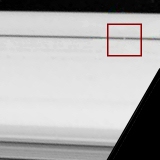 Voyager image of Pan within Saturn's Encke Gap. |
|
| PAN - MOON OF SATURN | |
| Pan was the Greek god of shepherds and sheep. He was a Satyr, one of a number of woodland gods which had horses' ears and a tail. The Roman version of Pan had a hairy body, wrinkled face, goats horns, and carried a reed pipe. He was the son of Hermes and Penelope. Pan was discovered by M. Showalter in 1990 using Voyager images. | |
| Orbit | |
| Pan is Saturn's innermost satellite. Pan orbits 133,583 kilometres from the centre of Saturn, just 62,091 kilometres above the cloud tops. Pan has a circular orbit which lies in Saturn's equatorial plane, and completes an orbit in under 14 hours. Pan is located within Saturn's A-ring Encke Gap. It appears to be a shepherd moon, maintaining the Encke gap, keeping it clear of small particles. Pan was discovered in a review of Voyager images when patterns in the A-ring were found which hinted at the presence of a small moon. | |
 The orbits of Pan, Atlas, and Prometheus. |
|
| Physical properties | |
| Pan, with a diameter of just 20 kilometres, is Saturn's smallest satellite. Pan's mass and density are unknown. | |
| Interior | |
| There is no information concerning Pan's interior. | |
| Magnetic field | |
| No magnetic field has been detected. | |
| Atmosphere | |
| No atmosphere has been detected. | |
| Surface | |
| In the best images Pan is a small fuzzy blob. It is a moderately reflective object with an albedo of 0.5. | |
|
|
|